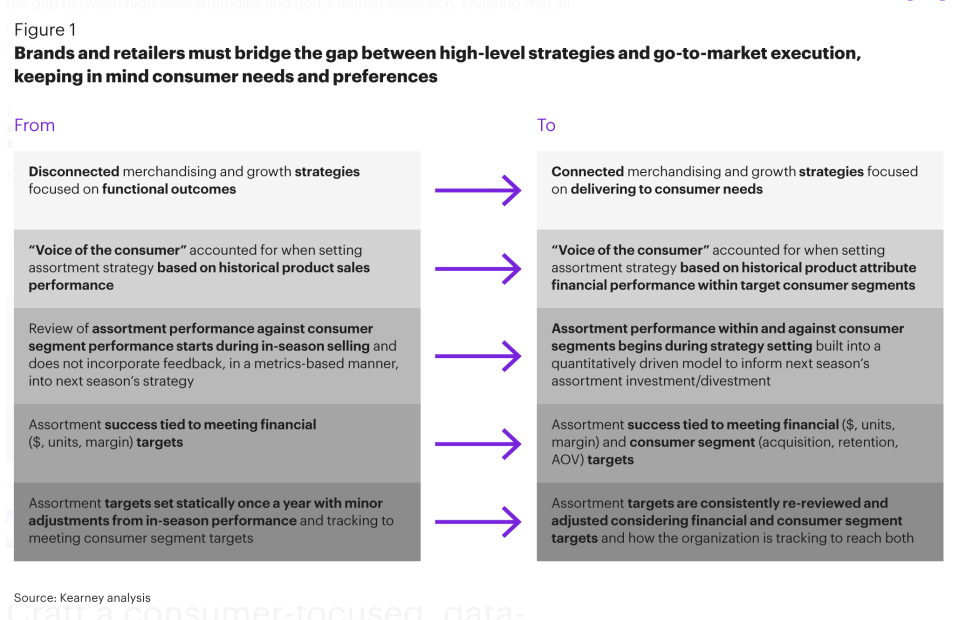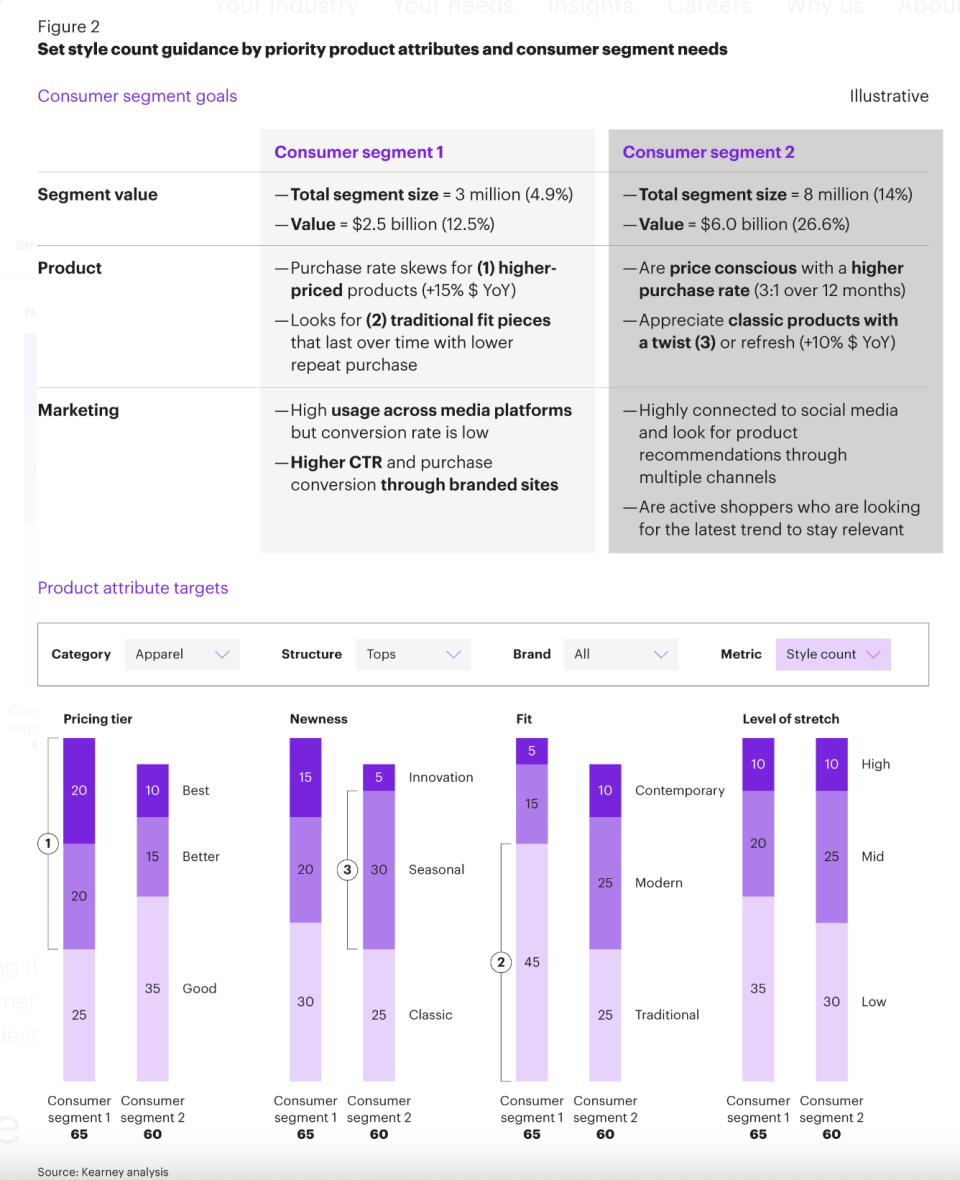Unlocking Retail Growth Potential

There’s a better way.
For apparel brands and retailers, the shifting business landscape offers the perfect opportunity to rethink assortment strategy, connecting growth and merchandising strategies more closely based on consumer trends and data.
More from WWD
Target's Discretionary Pullback Leads to Profit Gains, but Outlook Cut
The 25 Best Bras for Large Busts That Ensure You Feel Supported
The retail landscape continues to undergo rapid change and disruption as market and consumer needs shift. For example, amid mounting concerns of a recession, we have seen off-price and discount retailers looking to the future with strong growth expectations (8.2 percent compound annual growth rate 2023-2029). Moreover, direct-to-consumer and challenger brands are predicted to grow at a CAGR of about 23 percent through 2023, all while consumers are exploring and engaging with new channels and mediums faster than before. Most brands have struggled to pivot in response to these trends, much less capitalize on them.
In this challenging market context, we encourage apparel brands and retailers to recognize that consumer expectations and demands are only accelerating retail landscape shifts. In recent years, many retailers and brands have announced growth strategies as a way to better meet quickly changing dynamics, but this is easier said than done. As just one indicator, retailers, department stores, and apparel holding company share values have dropped considerably from 2021 to 2022 at -26 percent, -34 percent, and -31 percent, respectively.
In this article, we’ll first consider what’s hindering brands from delivering growth and assortment strategies that are connected and better grounded in consumer needs, then discuss steps to make this happen.
The missing connection
Despite mounting competitive and consumer-driven challenges, most apparel retailers and brands have not substantially altered how they determine what products to bring to market.
On the surface, that may not seem true. That’s because companies in this space have made significant advances in areas including digital, omnichannel, customer experience and personalization, guided by high-level strategies with specific channel and customer targets in mind. But these strategies, in many cases, are set aside as functional teams embark on seasonal development work. This disconnect between strategy and go-to-market execution hampers retailers’ progress in developing and bringing to market offerings that address current consumer needs and can drive larger returns.
To address that reality, brands and retailers must integrate consumer data and insights fully into decision-making across the entire go-to-market process. Although some businesses deploy in-season tactics that incorporate such data-driven insights, they must also focus on decision points with longer lead times, multiple iterations and cross-functional inputs.
Leaders, moreover, must look to create much stronger connectivity between growth strategies, merchandising strategy, and consumer needs and targets. Tying product attribute targets to consumer segment needs will enable retailers and brands to ensure they meet consumer needs regardless of changing channel, category or market dynamics. Put simply, to ensure growth and minimize risk, brands must efficiently integrate consumer preferences into their assortment strategy.
Consider two examples that reinforce this concept. Inditex (parent company of Zara) prioritized integrating in-store, consumer purchase patterns and sentiment weekly against its assortment targets and production cycles within a month. The tactic contributed to 27 percent net income growth in 2022 for the business. In contrast, Allbirds revenue sank 13 percent in the three months ending 2022 as the company “didn’t see sell-through on those franchises that we would’ve hoped for, and that came at the expense of that core franchise . . . we took our eye off the ball a bit.” Both stories underscore the need for businesses in this space to tactically connect strategy, merchandising and marketing functions to avoid stagnation and deliver growth. To win, brands and retailers must bridge the gap between high-level strategies and go-to-market execution, ensuring that all decisions have quantified linkages with consumer needs and preferences, as suggested in figure 1.

Craft a consumer-focused, data-driven assortment strategy
So, what’s the best path forward for apparel brands and retailers?
Brands should start by linking desired customer segment outcomes to their product assortment investments. This involves mapping assortments to quantified customer needs, acquisition, and penetration outcomes, and evaluating product offerings to ensure they meet consumer demands. By associating attributes such as classification, fashion-versus-basic and price tier with customer segment distribution, brands can optimize their product lines for both current and future seasons.
Again, this may seem self-evident, but the reality is that most brands develop consumer strategy and assortment strategy separately, only beginning to consider the two together when analyzing post-season performance. The future requires a proactive approach, connecting customers to assortment during concept and strategic investment phases. This shift requires brands to assess whether they have the appropriate products to reach specific customer segments, starting with strong foundations in the two areas below.
Assortment architecture. Brands need a comprehensive assortment architecture framework that is based on a consistent planning hierarchy, utilizes priority product attributes for target-setting ($, units, gross margin, styles), and considers overall financial investments/divestments and performance targets for product hierarchy.
Consumer segmentation. Brands must develop a robust customer segmentation strategy that is built on a multi-attribute model, defines value creation and winning strategies for each segment, and sets clear segment value and future targets.
As each segment displays distinct preferences for factors such as channel, price, classification and aesthetic, it becomes possible to quantify the required product types to achieve set objectives. Figure 2 provides an illustrative example of the process in action, with product attribute targets linked to the demands and needs of distinct consumer segments. The advantages of adopting a consumer-centric go-to-market strategy extend beyond initial assortment planning, as it will also influence in-season and post-season review and management.

Overall, brands adopting this connected approach to defining strategies can ensure that assortment and consumer strategies have a much higher potential for success in execution, instead of likely being destined to fail from the outset.
Take these steps
To effectively transition and reap the benefits of a model that aligns consumer and assortment strategies, brands should take the following practical steps.
Establish fundamentals. Develop comprehensive, data-driven assortment hierarchies and consumer segments with the necessary data and multi-attribution.
Align overall growth strategy with consumer segment outcomes. Cascade the North Star growth strategy to consumer segment outcomes, ensuring that organizational objectives align with customer needs and preferences.
Integrate go-to-market timelines. Synchronize key milestones within the end-to-end value chain, ensuring that both assortment and consumer strategies are reviewed, refined and finalized in tandem, in alignment with the overall go-to-market calendar.
Define clear roles. Determine the responsibilities and decision-making authority of individuals involved in the development, integration and execution of each plan. Equip these stakeholders with the skills necessary to effectively incorporate relevant information and insights.
Integrate data and insights. Ensure easy access to essential consumer information and establish data pipelines to enable seamless inflows to assortment planning infrastructure.
Evolve tools. Create assortment planning tools that can integrate data, measure quantified outcomes and assess assortment and inventory sufficiency to achieve planned seasonal performance outcomes against assortment requirements.
By aligning consumer and assortment strategies, brands can foster a consumer-centric approach that deepens their connection with target audiences and optimizes product offerings. Placing the consumer at the heart of decision-making from the outset enables brands to accurately meet demand, align production with genuine needs, deliver the right products to the right customers, and minimize overstocks, inventory gaps, stockouts, and markdowns. That will lead to substantial benefits including increased sales, reduced costs and enhanced profits, for sustainable growth.
In sum, by continuously refining and adapting assortments based on consumer insights, brands can connect and optimize their strategies for lasting success and resilience in an ever-evolving market.

Brian Ehrig is a partner in Kearney’s New York office.
[Follow this link to connect with Brian Ehrig]
Best of WWD

